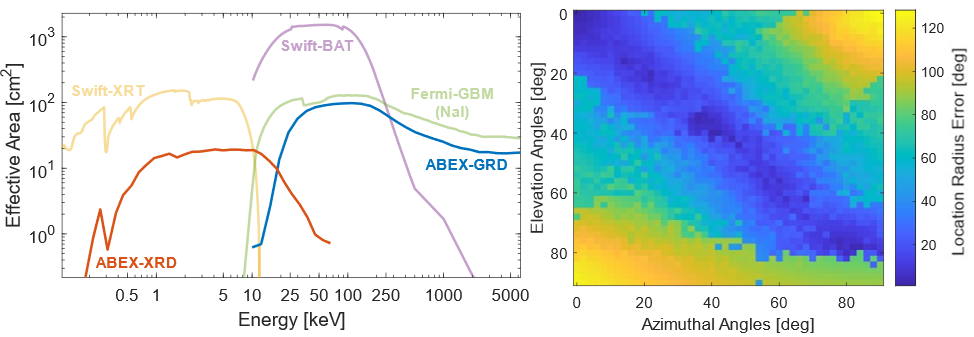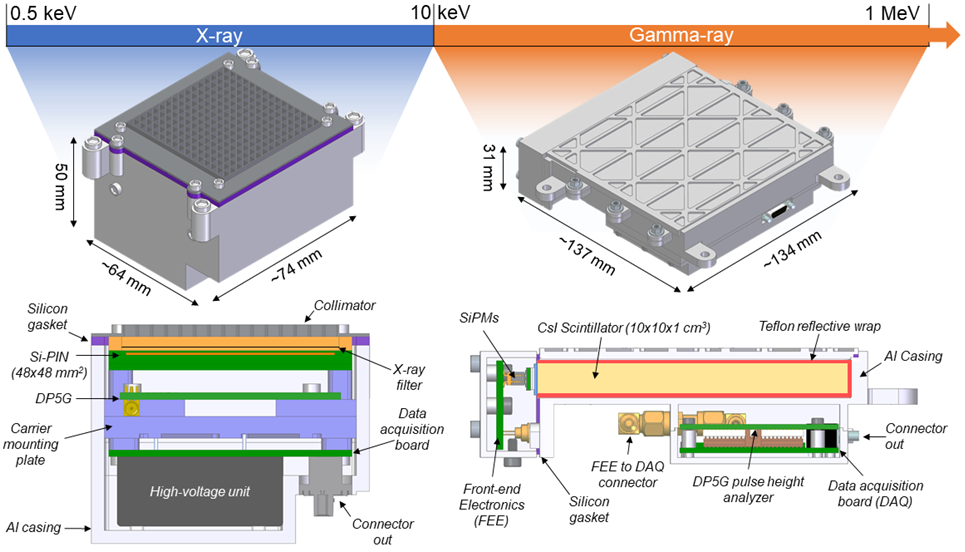Payload
The ABEX Payload systems are designed to observe the prompt emission from Gamma-ray Bursts (GRBs), which are highly energetic cosmological events that occur randomly in time and isotropic across the sky. To measure the emission of GRBs, ABEX uses a novel suite of X-ray and gamma-ray detectors that observe the energy of events with course localization using differential flux. Together these instruments will measure a wide energy range across a large field-of-view. Each detector generates time-tagged energy for each photon entering its sensitive volume. This generated data is then sent to a payload interface unit located in the spacecraft avionics. Data from the detectors is packeted together, sent to the spacecraft computer, and transmitted back to Earth where the scientific analysis is conducted by the ABEX Science Team. The payload design and effective area is shown below.
 ABEX will provide effective area in a wide-energy range.
(Left) Effective areas of ABEX compared to several ongoing
missions. (Right) Localization simulation.
ABEX will provide effective area in a wide-energy range.
(Left) Effective areas of ABEX compared to several ongoing
missions. (Right) Localization simulation.
 ABEX will fly specialized detectors to see a wide range in energy.
ABEX will fly specialized detectors to see a wide range in energy.
|
TPM |
Rationale |
Units |
|---|---|---|
|
Mass |
The total mass of the payload must remain with what is allowable by the system within the limits of the CubeSat. |
g |
|
Volume |
The total volume of the payload must remain with what is allowable by the system within the limits of the CubeSat. |
cm3 |
|
Operating Power |
The typical operating power must be provided by the spacecraft to gather the science data. |
W |
|
Science Data Volume |
The total generated science data which is stored on the payload must be allocated for in memory size. |
MiB |
|
Transmitted Data Volume |
The data which is sent back to earth must be determined for storage and transmission. |
MiB |
|
Peak Event Rate |
The expected peak event rate which determines the processing rate design value required by the data acquisition systems. |
events/s |
|
Maximum Collection Rate |
The maximum possible rate of detection which is achievable by the data acquisition system for the maximum deadtime requirement of 10% should be known to determine science capability. |
events/s |
|
Controller Logic Cells |
The controller must provide sufficient logic cells to perform the required operations for the payload control and data processing. |
(unitless) |
|
Metallic Structure Factor of Safety |
Structural elements must survive the launch and orbit environment. |
(unitless) |
|
Metallic Structure Minimum Fatigue Life |
Structural elements must survive the launch and orbit environment. |
Years |
|
Thermal Shock Factor of Safety |
Thermal control elements must be designed to prevent thermal shock from damaging components. |
(unitless) |
|
Thermal Gradient Factor of Safety |
Thermal control elements must be designed to prevent thermal gradients from damaging components. |
(unitless) |
|
Minimum Temperature |
Thermal control elements must be designed to prevent temperature ranges exceeding the limits of components. |
°C |
|
Maximum Temperature |
Thermal control elements must be designed to prevent temperature ranges exceeding the limits of components. |
°C |
|
Effective Area |
The payload must provide sufficient effective area to meet the science requirements of collecting enough photons. |
cm2 |
|
Energy Range |
The energy range must be sufficient to meet the science requirements of observing emission ranges of interest. |
keV |
|
Field-of-View |
The field-of-view of the combined payload must be sufficient to meet science requirements to observe enough GRBs. |
% |
|
Analysis Tool |
Description |
TPM |
|---|---|---|
|
Thermal Desktop |
3-D thermal modeling for the XRD and GRD assemblies. |
Thermal Shock Factor of Safety
|
|
ABACUS |
3-D structural modeling for the XRD and GRD assemblies. |
Metallic Structure Factor of Safety
|
The ABEX Payload uses two kinds of detection approaches. The first is solid state detection with its X-ray Detector (XRD), using a large area Si-PIN sensor. This sensor directly measures X-rays through the current pulses they generate in the sensor. The current is processed by front-end electronics and sent to a pulse height analysis unit that determines the time and energy of the X-rays. To manage the X-ray background, The XRD uses a collimator to narrow its field-of-view with several detectors mounted at different angles across the spacecraft to observe a combined large percentage of the sky simultaneously. The second detection method is scintillation, used by the Gamma-ray Detector (GRD). The GRD uses a block of cesium iodide which interacts with gamma-rays to generate visible photons which are reflected to an array of Silicon Photomultipliers (SiPMs). The SiPM array generate current pulses, which are processed by front-end electronics that sum them together and provided this to the pulse height analysis unit that determines the time and energy of the gamma-rays. Each detector requires high voltage to operate the Si-PIN and SiPM sensors, which is provided by step up converters from the spacecraft power input and controlled by an FPGA located on the Payload Interface Unit (PIU). The PIU is the main controller of the payload, taking in data and providing command interface with the XRD and GRD with the spacecraft computer, packeting telemetry data and scientific data together. Combined the XRD and GRD suite works together with overlapping coverage to measure the spectra of GRBs. All data generated is stored in memory for several orbits, with internally triggered data sent back to Earth at the soonest downlink window and an option for the science team on Earth to request data from regions of interest from the memory in the next downlink window.